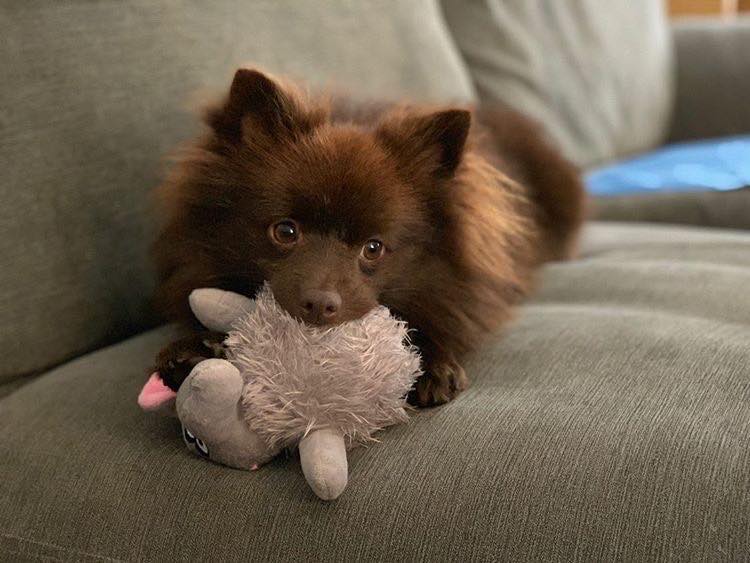No one likes to think of their doggo being sad when they’re on their own, but we do have to leave them sometimes! With a little dog training and a bit of patience, you can help your pooch handle separation anxiety so you can enjoy your time out of the house without worry.
Separation anxiety is common in doggos; they love us so much, it’s not surprising they don’t like to be parted! However, it’s a sign of a well-balanced pooch when they can cope with short stays at home on their own, so we’re here to help you achieve it. Whether your pup is young or old, here’s the inside scoop on separation anxiety in dogs and some dog training tips to help them feel more comfortable, and less anxious.
What is separation anxiety in dogs?
Separation anxiety can happen for lots of reasons, and it can be upsetting to dog parents and doggos alike. If your dog barks, whines and acts destructively when left alone – that’s separation anxiety! These signs of anxiety are caused by your fur-pals distress at being parted from you. Sometimes the behaviour starts before you’ve even gone anywhere – we’ve all seen those big puppy-dog eyes come out when we pick up our keys and put on our shoes.
Many dogs will pace or whine for the first 20 minutes they are alone, before they settle themselves down to sleep. Some pooches don’t settle, though, and try to relieve their stress instead. Unfortunately, destructive behaviours such as chewing can release calming hormones, so this is one of the strategies many doggos will have a go at. Other dogs may make a mess inside, even if they are toilet trained. Poor Fido!
So what do you do when it escalates and starts to bother your neighbours, and put your furnishings at risk? Well the first thing is to work out the triggers.
What causes separation anxiety in dogs?
Big changes, such as moving house, changing your routine or getting a new housemate/pet/baby can cause your fur-pal to feel uneasy. Essentially, your dog feels unsafe in your absence and can’t cope with the feeling. Sometimes, noises from outside or next door can alarm a pet into acting anxiously, too. You can find out more about how to build a sense of security and steps to mask those triggers further on.
For sudden and dramatic changes in behaviour that don’t have an obvious cause, your first port of call should be your vet. Pain and illness can make your doggo act very strangely, so rule those out before anything else.
🐾 Good Boy Top Tip: if you’re thinking of getting a puppy or older dog, don’t assume they will be okay alone even if they have in the past. Sudden changes – such as a new owner – can bring on separation anxiety in even the goodest of good girls and boys.
How to deal with an anxious dog?
If you return home to find a clean-up operation is needed, try to remember it just means your doggo has been having an upsetting time. It isn’t personal! Lots of research has shown that reacting negatively with shouting or punishment doesn’t work in these cases, as your furry friend isn’t able to relate the telling off to their actions in the past. Just ignore your pooch until you’ve cleaned up (and calmed down).
Now the immediate issue has been resolved, it’s time to look to the future! We have lots of tips to help you avoid a repeat of the behaviour. For example, crate training a puppy can help them learn how to cope with being alone in small steps. Older dogs, even rescues, can also learn better habits over time – as long as you’re patient and don’t expect miracles overnight. Let’s get started with some of those tricks!
Start small – baby steps
When you start to work on separation anxiety, it’s important to go very slowly. The aim is to help your dog realise that they’re safe on their own and you will come back to them eventually. It’s easy to tell if you’re moving too fast, because you’ll see the distressed and destructive behaviours again. The aim is to not let your faithful friend get to the point where they have to destroy things to make themselves feel better. Sounds easy, right?!
Start by building up the amount of time your doggo can see you, but not get to you. For example, set up a stairgate in a quiet room, so puppy can watch you while you do some housework. Don’t talk to him during this exercise! Before you leave you can give him a dog treat if you think it’ll help distract his attention. Dog food puzzles and chews are good options for doggos that really just want you by their side the whole time. Try to come back into the room before they have finished (and started whining), and slowly build up their tolerance this way.
🐾 Good Boy Top Tip: try to only return to the room he’s being quiet, so he learns that you don’t come when he’s whining. Don’t make a big fuss – your coming and going should be completely neutral.
If he starts to whine while you are in sight, try saying ‘No’ and turning your back, or walking out of sight. That usually makes them stop for a moment, so calmly say ‘Good boy’ and return to where they are. If it doesn’t work and they keep whining, try sitting down a little distance away from the stairgate, but within view. If that soothes them, when they stop crying you can go in for a cuddle!
Try this every day for as long as you think they can happily cope, and then start to build that time up. Once you’re at around 20 minutes, try using smaller dog treats, instead of chews, and try it more than once a day. If you slip up and leave it too long and your pupper starts whining or barking, you may have to go back a few steps and build up again more slowly.
Practice ‘out of sight, out of mind’
Once you have this little technique down, you can try it in different rooms. That might help you get an idea of which rooms they will be most comfortable left alone in. Then, slowly build up to leaving your fur-pal in one room while you go out of their line of sight. Using the same methods, build up the time you can be out of sight for day by day. Start small – just because your pooch is happy watching you wash up for an hour, doesn’t mean they will be happy not seeing you for that long!
🐾 Good Boy Top Tip: get a little pet camera that you can watch from your phone, if you can. It will help you with the next step in this trick!
Hopefully, you’ll find your dog is less prone to following you around and you can get them to settle down in one room while you’re in another for a while. If that’s the case, you’re ready for the next stage!
Take the training outside
Try leaving the house and just sitting on your doorstep for a couple of minutes, and then returning. If you can do that, it’s pretty much more of the same from here. Keep building up the time, and pop outside for a few minutes three or four times a day. Use the pet cam if you think they may find this difficult, so you can keep an eye on them and return before they start barking or chewing. Some cameras let you talk to your canine companion, so you can ask them to sit or lay down if you see any naughty behaviour creeping in; then, just come back inside while they are behaving.
You can then start to build this time up until your doggo is used to you going in and out and isn’t phased by it. Remember to keep up the food puzzles and chews if it helps! It can take weeks or even months to build up to longer periods of time alone, and some dogs may never make it to more than a couple of hours. You’ve just got to work with what you’ve got, and remember that setbacks can happen. Just start this method again and you’ll soon be on the path to success.
What about crate training?
Crate training means different things to different dog parents. One way of crate training that can be really beneficial for most doggos is to provide them with a cosy, covered crate that they use as their safe place. This means no one bothers them when they’re in there – at all! You can even try feeding them in their crate to make it feel like the best place in the world. This can help poochs with their separation anxiety by giving them somewhere to hide.
Other tips and tricks
There really is no shortcut to helping your little friend feel comfortable on his own, but there are some temporary measures you can use to protect him (and your belongings) while you practice. For example, learn how to fully dog-proof the room he is left in. As well as food, items that doggos love to get their teeth around include those that look like toys, or smell like their favourite people! That can include kids’ toys, your clothes or shoes… even your most-loved cushion or blanket.
🐾 Good Boy Top Tip: there are many calming supplements available. Some mimic calming hormones, others rely on soothing plant extracts. Talk to your vet to see if they recommend anything that might help your pooch relax.
Try to drown out external noises by playing classical music on low while you’re gone, and keep the curtains closed (and a light on) to avoid barking at strangers passing by. Turn time alone into a treat, with food puzzle toys and chews to keep them occupied. If you can, put your answerphone on or mute incoming calls when you’ll be away from home, and avoid leaving your pooch alone if there are likely to be fireworks going off!
🐾 Good Boy Top Tip: don’t leave your dog with access to the whole house. A small space can feel safer, particularly if there’s one room that is nice and quiet.
Some dogs get wise to your routine and get all worked up at the thought of you going, so make sure your ‘leaving the house’ routine isn’t too long or predictable. A quick goodbye as you leave doesn’t do any harm, but try not to drag it out!
What if it doesn’t work?
If you are having ongoing problems or your little fur-pal is reacting very strongly to alone time, don’t be afraid to go to the vet. They can offer friendly advice and put you in touch with specialists who can help you on a one-to-one basis; some of these services are covered by pet insurance, too. There is lots of good information on the internet, so read up on dog behaviour and separation anxiety and work out a plan of action to help you and your fur-pal tackle this together.
Separation anxiety can be stressful for both you and your fur-pal, but we know you’ve got this! With a little practice, some dog training and a few dog treats along the way, you’ll be enjoying time away from home while your pooch snoozes away in no time.




